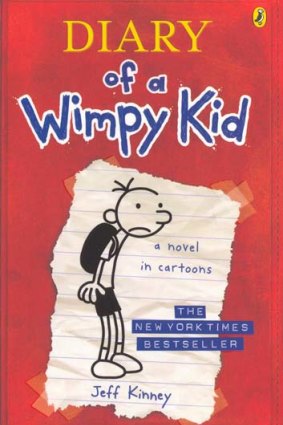Teenagers have lower comprehension levels than they did last year and their favourite books include the primary school-level Diary of a Wimpy Kid, according to a national report on reading habits of adolescents.
Analysts say students are spending more time on devices and consuming fewer books that require sustained focus, which may be negatively affecting the size of their vocabularies and ability to comprehend trickier texts as they opt for familiar and easier material.
The 2024 What Kids Are Reading Report was compiled by reading software company Renaissance Learning using data from their Accelerated Reader program, which is used by 62,559 students across 440 schools in Australia.
It found the average number of books students had read increased from the previous year, but comprehension scores among students in years 9 to 12 declined.

Suitable for primary school children, read by high schoolers: Diary of a Wimpy Kid by Jeff Kinney
Some of the most popular books read by students in the older grades of high school are aimed at primary school-aged students.
Seven Harry Potter novels were in the top 20 list for years 9 to 12, as well as four volumes of the Diary of a Wimpy Kid franchise. Australian author Steven Herrick’s book written in verse, The Simple Gift was the most popular book for older high school students.
Renaissance Learning’s head of Australia and New Zealand, Diana Wing, said the rise of digital platforms such as YouTube and TikTok meant students may be spending less time with books that require sustained focus.
“Students need to engage with more complex texts to improve their reading skills, but many continue to choose familiar, easier books,” she said.
“The Australian publishing industry has an opportunity to offer more diverse, challenging young adult content that resonates with older students,” she said.
Best-selling children’s book author Andy Griffiths agreed that digital technology was stealing concentration time of emerging readers as well as adult ones but said, when it came to the publishing industry, there was “a wider range of books being published today to suit many different reading tastes and readers (both young and old) than there’s ever been”.
“Even taking the distraction of digital technology into account, I wonder if these results are also beginning to show one of the many downsides of schools — through both the underfunding of state education and an over-emphasis on testing and measurable outcomes — having to downgrade or dispense with their libraries and librarians,” he added.
In NSW, the Department of Education provides funding for teacher librarian hours based on the number of students enrolled at a school. A national survey of librarians released in 2022 found more than one-quarter of Australia’s school libraries cut their budgets and staff numbers during the pandemic.

Declining funding for facilities such as libraries has taken a toll on what students are reading, says popular children’s book writer Andy Griffiths.Credit: Jason South
“We wouldn’t just assume that kids are going to transition from their times tables to algebra without a mathematics teacher to guide them. Likewise, the librarian has an essential role to play in being able to suggest the next step on from an author or a series that a particular reader has enjoyed,” he said.
Griffiths said libraries were essential to building a school’s reading culture and ensuring that students, teachers and parents have access to – and knowledge of – a wide spectrum of books.
“Ideally, every school and school librarian would also have a close relationship with their local bookseller or supplier to ensure they are fully abreast of the multitude of suitably challenging books already being published to assist students in their growth towards becoming life-long readers,” he said.
La Trobe University education professor Pamela Snow said about 10 per cent of Australian students were arriving at high school with very poor reading skills, meaning they could not read with ease and reading a text was not an enjoyable experience.
“We have got to move beyond being functionally literate to being able to read a range of complex texts and being able to critically consume information,” she said.
“If you’re not much of a reader, you’re not acquiring incidental background knowledge. And that is one of the biggest predictors of reading comprehension; the knowledge you bring to a text is one of the biggest predictors of how well you’re going to read that text.”
Snow said teachers played a key role in helping students decipher complex words in the English language and breaking down ways to enjoy books, which in turn made students more likely to tackle complex novels.
“English has a large vocabulary because we’ve borrowed from so many other languages. So to be able to engage with complex texts, students need a rich vocabulary, but to get a rich vocabulary, they need to engage in complex texts,” she said.
The Morning Edition newsletter is our guide to the day’s most important and interesting stories, analysis and insights. Sign up here.